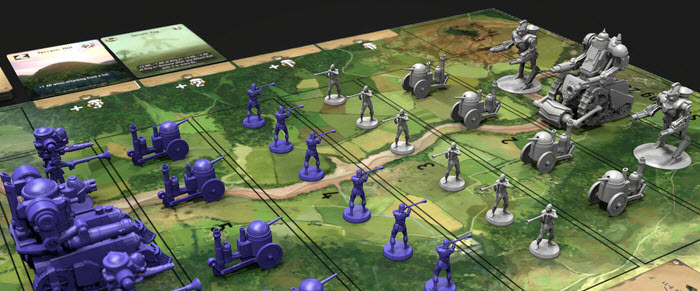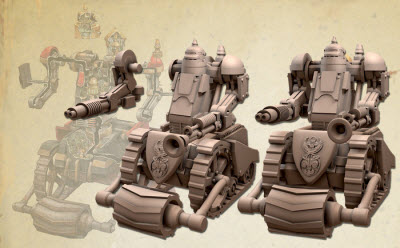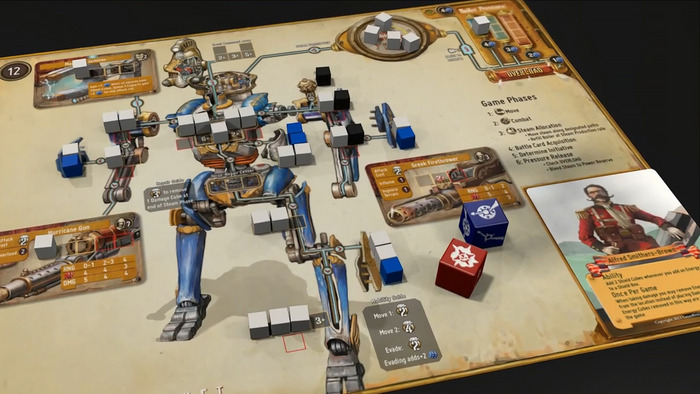For a lot of people, history is a boring school subject. Why bother learning about how George Washington chopped down the Liberty Bell to distract the Soviets, right? What’s the point in learning that stuff…unless it’s about battle. Forget social change, innovation, the intrepid and insoluble pioneering spirit of human nature. Show me warfare, damn it. Give us Roman phalanxes, cavalry charges, aerial dogfights, and the tactical battlefield geniuses who brought their enemies low. Seriously, just turn on the WWII channel (formerly known as the History Channel) and we’ll be good here.
If that’s how you approached this subject, then strap in for one hell of history a history lesson.
Welcome to Heavy Steam, a tactical board game clearly inspired by the successful MechWarrior video game series, which were in turn a direct port of the tabletop wargames MechWarrior and BattleTech. It’s like Inception for mechs…Inmechtion.
Enter an alternate 19th century Earth where various world powers have taken the marvel of steam power to its logical conclusion: giant battlefield machines. Here, players take command of hulking behemoths of hissing pipes and gears, and victory is through the chest plates of your opposition.
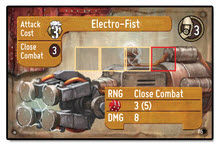
Who wants some fisticuffs?
Prototype Shown
Heavy Steam is a game of strategic warfare for two to four players, consisting of two opposing factions with a pair of unique mechs, called Steam Titans. Steam Titans come in either a tank-like Heavy form, or a more agile bipedal Light form. Heavy Steam offers numerous initial choices, such as which Scenarios, Steam Titans, and pilots to use. The most appetizing choice, though, is the customization of your weaponry. Gatling gun or flamethrower? Rocket launcher, or proto-rail gun? The choice is yours.
Gameplay in Heavy Steam has a lot of moving parts to it – literally. Each Steam Titan placard starts with its initial compliment of steam cubes. (This would make sense, being steam-powered machines and all.) As players move about, fire weapons, or execute strategic command options (i.e. drawing cards), steam is spent. These cubes are moved to the Titan’s boiler reserves, expending energy and building up pressure within the mech’s closed system. The more actions the Steam Titan takes, the more the pressure builds. However, this also makes the Titan more vulnerable to getting hurt.
After players decide whether they want to move or not, they try to wallop one another. Weapons are fired one at a time – probably as a way to maximize their epicness on the battlefield. Combat in Heavy Steam is managed by a series of six-sided success / failure dice rolls. Each weapon offers a number of attack dice based on the weapon’s strength and distance from the target. By contrast, the number of defense dice available is dependent on the current state of boiler pressure. If there aren’t more attack successes than defense, the weapon sails wide, off the battlefield, and probably blows up a rustic cottage somewhere. If the weapon does connect, damage is assigned. The more damage you inflict on a mech, the harder it becomes to move, fire, and, well, live.
Play continues back and forth until all combat actions are taken. Then players allocate steam in their systems. Steam always moves outwards from the core to the limbs, which in turn power important things like shields and guns and more guns and moving and buying cards and guns. (Plus something about guns.) The rest of the round consists of players purchasing battlefield cards, determining which side gains initiative for the following round, and releasing some of that extra boiler steam back into the system. This keeps going until victory is secured and one side lays battered, tattered, and scattered across the European countryside.
Ostensibly, Heavy Steam is about three things:
#1. Playing With Mechs
Whether they’re powered by nuclear drives or steam engines, there is an appeal to giant mechanical suits. (It’s so popular, in fact, that there’s an entire genre of Japanese anime specifically focused around it.)
Heavy Steam plays into this idea by letting players customize their steampunk-themed minis with exchangeable weapon build-outs. Heavy Steam has translated that allure of mechs into a tactical board game with a variety of strategic options, but it also knows full well that is what its central appeal is.
#2. Resource Management
Maintaining steam-powered machinery can be tireless work, and that’s when they aren’t 100-foot-tall engines of doom. Unsurprisingly, Heavy Steam has some regular upkeep. Each placard details the machine’s current state, represented by various cubes. There are your normal steam cubes, but also shield cubes, damage cubes, and so on. And then you’ll be moving them around if you do anything beyond standing there looking intimidating. Heavy Steam doesn’t fare well if it comes against a dreaded Mecha Feline as a result. That said, between players leveraging their allocated steam and other battlefield resources such as infantry, the result is a game of strategic steampunk warfare.
#3. Combat
The game has a handful of non-fighting phases, such as maintaining the Steam Titan’s health, but that’s only a means to an end. Heavy Steam thrives on letting players slug it out with one another, and it doesn’t hide this fact. Quite the opposite. Combat is straightforward and designed to be accessible for a number of players, thanks to dice rolls and easy to understand weapon readouts. And, just like real battle, Heavy Steam can be a drawn out stalemate or a quick rout.
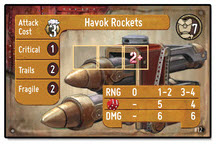
It’s a blast! A ha ha.
Prototype Shown
In a lot of ways, Heavy Steam is a modern successor to the old BattleTech wargames, except that the players use physical components instead of mech sheets, and it does away with heat sync and low-damage tedium that often accompanied those original games. Heavy Steam is designed to be faster, shorter, simpler, and much more visual; it generally succeeds on all those gears.
Moreover, while Heavy Steam appears to be minis-centric, most of the game’s actions take actually place via the Steam Titan boards and combat dice – although the minis are a nice selling point. At its core, the game is about harnessing the power of steam and unleashing it in devastating ways that James Watt* could have only dreamed of. If you feel you have the drive and pistons to pilot a Steam Titan of your own to victory, then you’ll want to head over to its Kickstarter.
*Who is James Watt? Don’t worry about it. Just more of that pesky history stuff.

